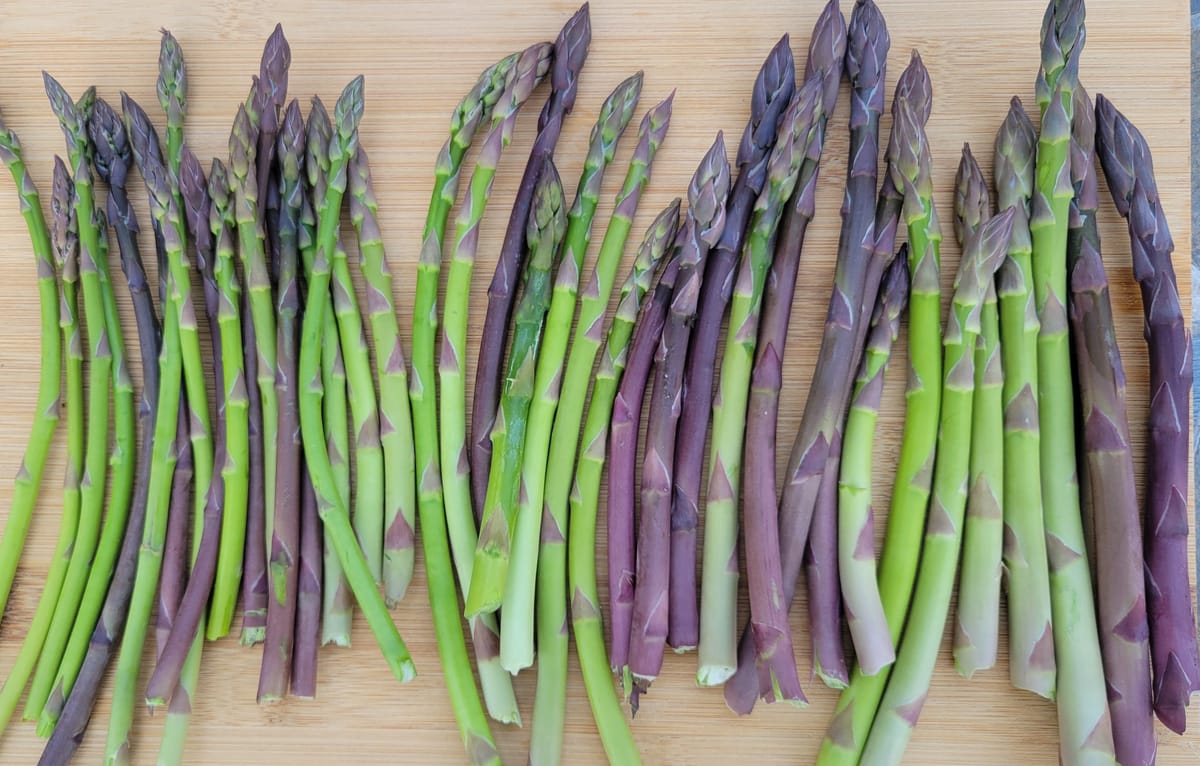On My Plate: Asparagus
Asparagus comes in two main varieties in the U.S., green and purple. Both are more nutritious when sourced locally, James Rubenstein writes.

Daffodils and migrating birds may be spring harbingers around Oxford, but for local food lovers, the most-awaited sign of spring is local asparagus in the Farmers Market. For several weeks, faithful farmers market shoppers have inquired of vendors and of each other, “Are the asparagus here?”
Last Saturday, the first small batch of local asparagus did arrive at Oxford’s Farmers Market, courtesy of Downing Fruit Farm. As I entered the farmers market one minute after it opened, Rachelle Downing immediately caught my eye. “Sorry,” she volunteered. “We had only a small amount of asparagus, and two shoppers bought all of it.” Fortunately for me, one of the two was Charles, a close friend, who kindly handed over a bunch.
Most folks know that corn tastes best when it is local and freshly picked. The difference between young and old asparagus is even more striking than with corn. Freshly picked local asparagus is sweet, tender and low in acid, but like corn, most of the sugar in asparagus converts quickly to starch. So by the time asparagus grown in California and foreign countries gets into the Midwest industrial food system, it loses its sweet flavor and nearly all of its nutritional value.
Asparagus comes in three colors — green, purple, and white. Green and purple are both available in Oxford’s Farmers Market. White is popular in Europe but rarely grown in America.
The difference between white and green asparagus is the growing method. White asparagus is grown underground and lacks chlorophyll as a result, depriving it of green coloration. Europeans prefer white asparagus because they think they are milder, more tender and less bitter than green ones.
Purple asparagus is genetically different from the green and white varieties. Stalks are purple on the outside, but the interior is the same as green ones. Purple asparagus is less fibrous than green and therefore slightly more tender, and the purple variety is sweeter because it has about 20% more sugar in its stalk than the green variety.
A distinctive feature of local asparagus compared with the industrial version in the supermarket is the wide variety of size. My most recent batch of Downing Fruit Farm asparagus ranges from 4 inches to 7 inches in length and from 1/8 inch to 3/4 inch in diameter.
The smaller-sized stalks are especially suitable for grilling or roasting. Place the stalks on foil, sprinkle some olive oil, garlic and herbs, wrap the foil around the stalks, and place the package on the grill or in the oven for around 5 or 10 minutes. The large ones need to be chopped into bite-sized pieces, especially suitable for stir-fries.
Local asparagus can be served with an oil and vinegar dressing, or simply unadorned. That’s what happened to me many decades ago when I was living in London and a local friend invited me to dinner at his aunt’s mansion straight out of “Downton Abbey.” At the dinner table, surrounded by an array of crystal, china and silver, a butler placed on each diner’s plate a first course of a half-dozen unadorned steamed asparagus. Not knowing which of the intimidating collection of silverware to use, I waited for others to start eating. To my amazement, these elegantly dressed folks picked up the asparagus spears one at a time with their fingers and popped them in their mouths.
In the weeks ahead, plenty of asparagus will appear in the Farmers Market. Then it will disappear for another year and be replaced with other local produce.
James Rubenstein is president of the Board of Directors for the Oxford Free Press and professor emeritus of geography at Miami University.




